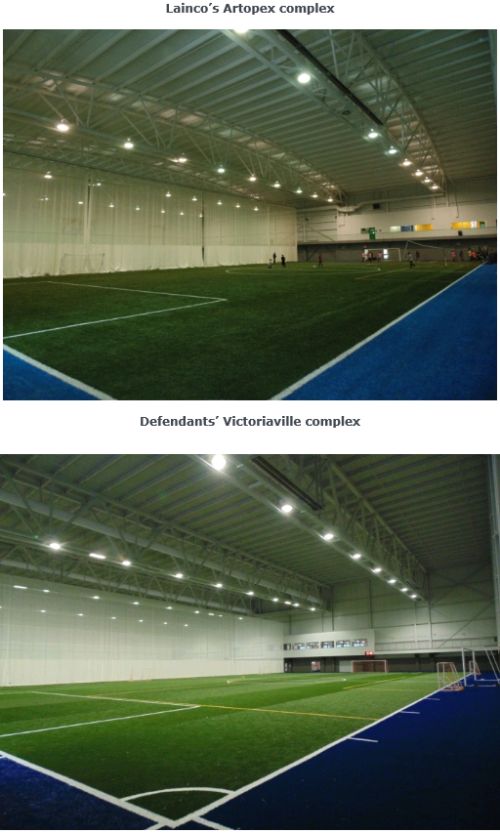On September 12, 2017, the Federal Court issued its decision in Lainco Inc v Commission Scolaire Des Bois-Francs et al, 2017 CF 825, confirming that the plaintiff's steel structure for an indoor soccer complex could benefit from copyright protection as an "architectural work" under the Copyright Act in Canada. This is the first time in nearly 50 years that a building structure has been granted this protection by Canadian courts.
In the case, the Court held that Lainco's copyright for the unique visible steel structure of an indoor soccer complex had been infringed by the defendants — a school board, engineering firm, architecture firm and general contractor — who together designed and built a nearly identical structure. The Court made this finding despite the building structures' functional nature, confirming that such structures can be protected as "architectural works" as long as they are the fruit of talent and judgment and incorporate an architectural or aesthetic element. The Court also held that notwithstanding their different roles in the infringement, all defendants were jointly and severally liable for the plaintiff's damage, which it assessed at over $700,000.
The plaintiff Lainco Inc ("Lainco") was successfully represented by François Guay and Jean-Sébastien Dupont of Smart & Biggar's Montreal office.
Background
Lainco specializes in the design and construction of steel structures and had designed the structure of the Artopex indoor soccer complex. Compared to more traditional structures for similar complexes, Lainco's unique concept provided an esthetically distinctive interior look characterized by an essentially unobstructed ceiling and generally a more open design.
The four defendants, a school board, engineering firm, architecture firm and general contractor, collaborated to design and build a similar structure in Victoriaville, Quebec for an indoor soccer complex in the context of a call for tender for which Lainco had also bid. Lainco alleged that this structure infringed its copyright in the structure for the Artopex complex.
Judgment of the Federal Court
Originality
Relying on the testimony of Lainco's head engineer, who explained that the design of the Artopex structure resulted from lengthy trial and error with regard to the arrangement of various structural elements in order to provide a cost-efficient and aesthetically pleasing result, the Court held that the design of Lainco's structure was not a purely mechanical exercise but rather the fruit of talent and judgment, thus benefiting from protection as an original architectural work under the Copyright Act.
Copyright Infringement
Two of the defendants raised the exception provided at s. 64.1(1)(a) of the Copyright Act to the effect that the Victoriaville structure could not amount to infringement because its features were purely utilitarian. The Court rejected this argument at the outset noting that the majority of architectural works have a utilitarian aspect and that, in this context, the s. 64.1(1)(a) exception did not apply to features that also incorporate an architectural or aesthetic element.
On the issue of infringement, the Court had no doubt that the defendants had access to Lainco's structure in light of evidence that representatives of the school board and engineering firm had taken photographs and notes of its appearance prior to the design and construction of the Victoriaville complex. In fact, the Court recognized striking similarities between these photographs and a pre-construction 3D design of the defendants' Victoriaville complex project and, with regard to the appearance of the final structures themselves, the Court noted that "a picture is worth a thousand words":

The Court found that despite the difference in fine engineering details and the fact that the defendants had expended efforts in adapting the design of the Victoriaville structure, they had ultimately reproduced a substantial part of the Artopex structure and thus infringed Lainco's copyright.
Calculation of Damages
The Court awarded Lainco damages that were calculated at over $700,000. In calculating damages, the Court notably held that it should not deduct the profits Lainco earned on projects it actually completed during the time it would have completed the Victoriaville complex had it won the call for tender, noting that Lainco could have increased its production capacity if necessary. Importantly, the Court also found that Lainco's damages should not be calculated on the basis of the revenues earned by the lowest winning bidder in the call for tender, but rather on the amount of Lainco's actual, higher bid.
Conclusion
This decision demonstrates that the Federal Court will enforce the copyright in functional building structures if they are architecturally original. Rights holders in this type of industry also now benefit from an important precedent in the context of public calls for tender, especially as the Court recognizes the added value of original architectural works in the calculation of damages.
The defendants may appeal as of right.
The preceding is intended as a timely update on Canadian intellectual property and technology law. The content is informational only and does not constitute legal or professional advice. To obtain such advice, please communicate with our offices directly.
